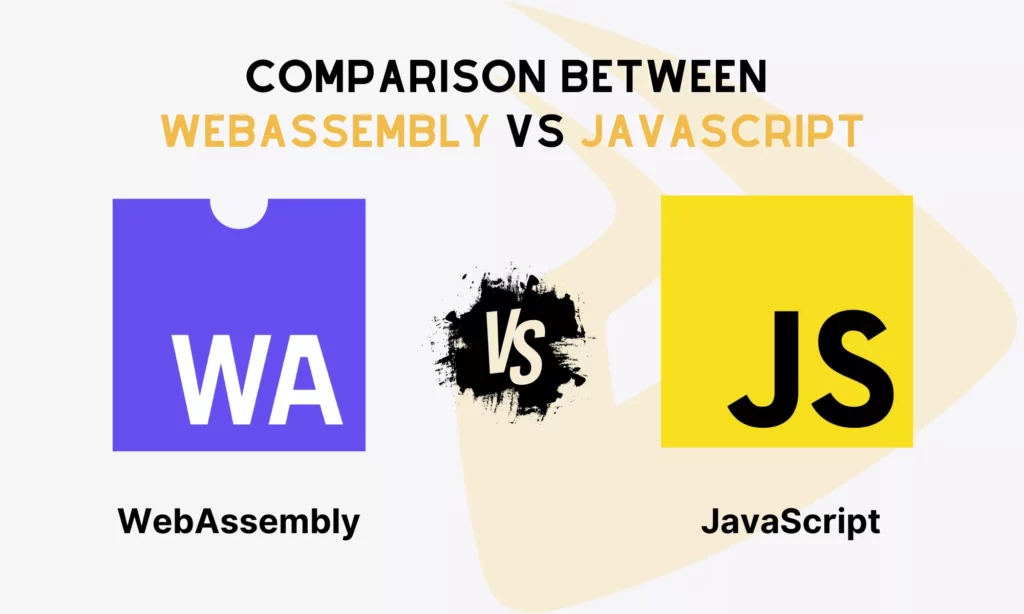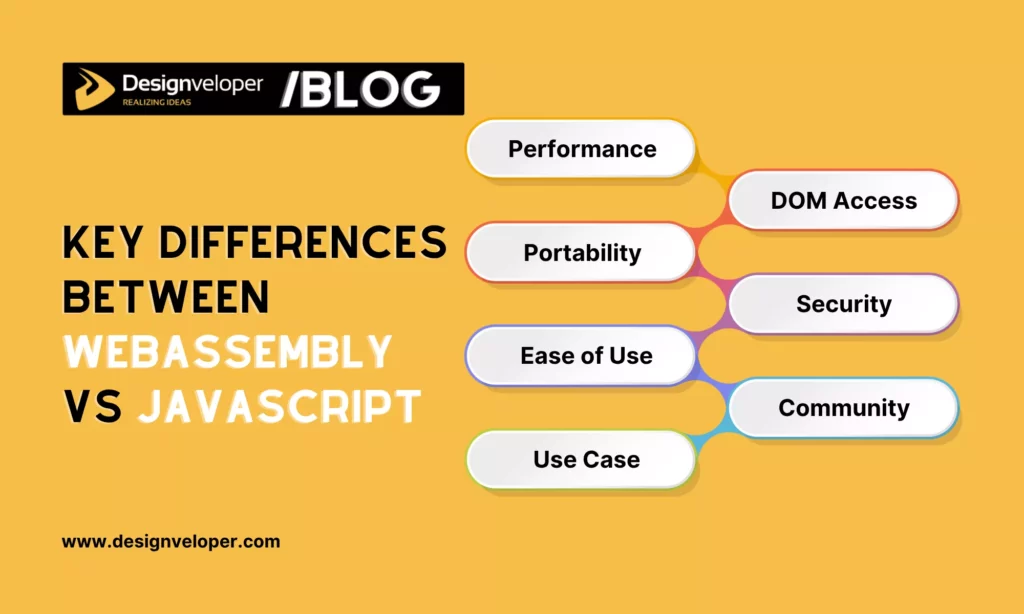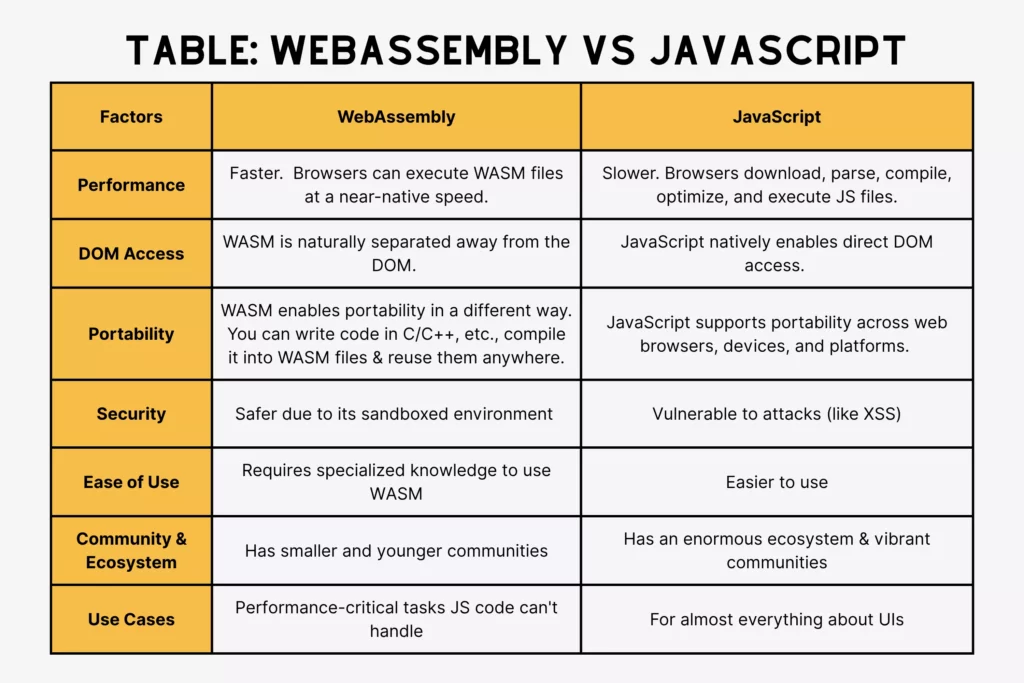WebAssembly vs JavaScript: Key Differences, Performance & Use Case
November 20, 2025


WebAssembly (WASM) and JavaScript (JS) are the two biggest players in the whole web execution game. And honestly, they are often talked about as if they’re mortal enemies. But, they both do critical jobs, just in profoundly different ways. Are you curious about the key differences between WebAssembly vs JavaScript? If yes, don’t miss this blog post. Keep reading, and let’s learn how they work!

Understanding WebAssembly and JavaScript
But first, don’t rush to their different points. We want to set the stage for you to learn about what each actually serves and how they relate to each other in web development.
What is WebAssembly (WASM)?
Okay, let’s talk about WASM first.
WebAssembly isn’t actually a programming language that you can write in directly. Instead, it’s an assembly binary instruction format that can run on stack-based virtual machines.
It was launched for the first time in 2017 and developed by tech giants like W3C and Mozilla to run natively on the web.
You can use C/C++, C#, Rust, and other programming languages to write web-based apps. But these programs must be compiled down into machine code that your computer may understand.
In this case, you can wrap the code written in such languages into a tiny, efficient WASM file. Then, the browser loads this WASM file. As the file already has a low-level format, the browser can decode and execute it near-natively.
For this reason, WASM enables all computationally demanding tasks to run at lightning speed right on the web. We’re talking about such things as complex CAD apps, high-end video games, or something.
This trait makes WASM a powerful add-on to build high-performance web apps using C/C++, Rust, etc.
But you know what? Despite its powerful trait, WebAssembly is only used for 0.1% of all the websites; most of which have high traffic and require ultra-high performance.
What is JavaScript?
JavaScript is the king of all technologies, with 66% of users reported in 2025. Also, according to W3Techs, JS appears in a staggering 98.9% of all websites.
Unlike WebAssembly, JavaScript is a high-level, dynamically typed, interpreted scripting language. It makes websites interactive. From handling button clicks and making API calls to executing the Document Object Model (DOM) – everything dynamic on the webpage requires the involvement of JavaScript.
It’s actually pretty amazing how far JS has come. We’ve got incredibly optimized JIT (Just-In-Time) compilation now, which makes modern JS shockingly fast compared to the old days.
It’s built for versatility and accessibility, not necessarily for the raw, brute-force numerical processing power that WASM is targeting. It’s the glue, the essential orchestrator that makes the web work. You simply cannot have the modern web without it.
But, as we said, it’s dynamically typed and has to deal with garbage collection and all that DOM manipulation. So it just fundamentally has more overhead.
How Are WebAssembly and JavaScript Related?
WebAssembly was designed to handle heavy, performance-critical tasks that JavaScript doesn’t excel at. They include 3D rendering, scientific computing, complex game engines, and more. This makes many people think that WASM will instantly take over the throne of JS. But it’s a myth.
Right in the WebAssembly’s official design philosophy, you also see that WebAssembly is a complement to JS. JS itself still does what it’s best at, from writing general web logic and interacting with web APIs to handling the DOM.
“So how does WebAssembly support JavaScript?” you may ask.
A JavaScript module loads the WASM file, gives it essential data, and the file will perform computationally heavy-lifting tasks at lightning speed. When its work is done, WebAssembly will return the result to JavaScript. And JS will use that result to update the DOM or do whatever action your web app needs to take next.
So, don’t think they fight with each other. Instead, they complement each other’s strengths and compensate for each other’s weaknesses. They make your app more powerful in web environments.
FURTHER READING: |
1. Everything About the Dark Programming Language |
2. What is Kotlin: Definitions, Strengths & Usages |
3. Everything About the Ruby Programming Language in 2025 |
Key Differences Between WebAssembly vs JavaScript

WebAssembly and JavaScript may be the best buddies in web app development. But are there any differences between them? The answer is yes, and this is also our main discussion in this section. Here, we’ll compare these two techs in different aspects: performance, DOM execution, portability, security, ease of use, and ecosystem. Let’s dive in!
Performance and Speed
WebAssembly is faster than JavaScript. This is what everyone agrees upon.
But why? It all lies in how the web browser handles the code.
JavaScript, as we said, is interpreted and has JIT compilation. Behind the scenes, the browser downloads the text, parses it, identifies your code’s purpose, compiles it, optimizes it, and executes it. Well, this whole process truly consumes significant time, especially for large apps.
Turning to WebAssembly: it’s a pre-compiled binary instruction format.
After downloading a WASM file (which is already in a low-level format), the browser’s engine will decode and verify it very fast. It then directly executes the file at a near-native speed. With WASM, you can skip the parsing and compilation processes. For this reason, WASM helps deliver tasks much faster.
Imagine a scenario where your app has to deal with complex math problems, heavy data processing, and other computationally intensive tasks. WASM appears as a hero for your app to handle these tasks efficiently.
But remember this subtle thing: for small input sizes, WASM is consistently faster. But when the data gets really large, or the task involves constant back-and-forth communication with JavaScript (what we call the JS-WASM boundary cost), the performance gap can actually shrink. And in some rare cases, a highly optimized JS engine might even edge it out.
Integration & DOM Access
JavaScript enables direct DOM access, but WebAssembly doesn’t.
DOM, or Document Object Model, is a programming interface that presents each HTML or XML document in a logical tree structure.
JavaScript is natively designed for the Document Object Model (DOM). In other words, it can manipulate, traverse, and listen to events on the webpage elements.
Remember the time you click a button and a form or a new page appears. That’s what JavaScript does, and it excels at connecting directly all the objects in the whole page structure.
And WebAssembly? It’s opposite. It’s intentionally separated away from the DOM for simplicity and security.
So, WebAssembly naturally doesn’t have direct DOM access. It can’t change the text color of a <p> tag like JS does.
If a WASM module wants to update the UI (User Interface), it must call a JS function. JS, in this case, plays a translator role and executes the task on WASM’s behalf.
Portability
Both JavaScript and WebAssembly make web apps portable across devices, operating systems, and web browsers.
Every web browser and platform now supports JavaScript. The language also has a massive ecosystem, making it a perfect choice for almost all web client sides.
The way WebAssembly is a bit different. It’s not a language, but it supports a wide range of programming languages, like C/C++ or Rust. You can write code in these languages, compile it into WASM files, and reuse the code anywhere inside and outside web browsers (e.g., IoT devices).
Security

WASM is safer than JS due to its sandboxed environment.
JavaScript’s dynamic nature makes apps prone to security vulnerabilities.
One study has shown that cross-site scripting (XSS) is the most common web attack in Q1 2025 (40%), caused by malicious JavaScript files.
Besides, in 2025, the JS developer circle also witnessed a serious malware campaign (“Shai-Hulud“) compromising hundreds of JS/npm packages and installing worm-style scripts to steal credentials or execute code remotely.
As JS has direct access to the DOM, malicious scripts can manipulate it if developers aren’t careful.
And WebAssembly? This tech wins over JavaScript in security. Its module is designed from the ground up to be run in a memory-safe, strictly sandboxed execution environment.
The binary format, indirect DOM access, and its controlled import functions mean it’s much more resistant to code injection attacks and things like conventional return-oriented programming (ROP) attacks.
WASM is like a highly secured vault. You put your code in, it runs its computations, and then it hands the result back out through a well-defined, supervised channel (the JavaScript API).
Because of this isolation, WASM is often a great choice for running code from untrusted sources or for handling sensitive data processing right on the client side.
Ease of Use
JavaScript is much easier to use, actually.
JavaScript offers a low barrier to entry. It’s dynamically typed and interpreted so you just hit refresh to see your changes without compilation steps.
Its syntax is human-readable and generally pretty simple to pick up. For a beginner, you can be writing interactive code in an afternoon. Plus, you literally just need a text editor and a browser. It’s easy, flexible, and fast to iterate on.
WebAssembly, conversely, has a significantly steeper learning curve. Why?
Well, remember, you’re not writing WASM directly; you’re writing in a language like Rust or C++ and then compiling it. These languages require your deep understanding of things like manual memory management, static typing, and the compilation process.
That’s not all. You also have to learn about the build tools, set up the JS code to load WASM files, and debug the binary output. There’s a lot you need to learn with WASM, honestly.
So, WASM is powerful. But it requires more specialized knowledge and more complex development.
Community and Ecosystem
JavaScript has an enormous ecosystem and vibrant communities compared with WebAssembly.
JavaScript has existed for ages as the main language of the web. It has a mature, massive ecosystem of open-source libraries and frameworks – let’s say React, Vue, Angular, etc.
It also provides deep, extensive documentation, countless tutorials, and huge communities. Struggle with JS code or bugs? Don’t worry! The maturity of this language helps you find solutions and generate code faster (with fewer risks!).
WebAssembly’s community is smaller and younger, but growing rapidly. So its tooling and debugging support aren’t as polished or popular as in JS. If you encounter new problems that haven’t been documented or solved yet, it takes more time to find solutions.
But do you know what the cool thing about WASM is? Its ecosystem is a polyglot. Built by various programming languages like C/C++ or Rust, WASM can bring tons of battle-tested code to the web.
Use Cases
So, when should you reach for which tool?
JavaScript is still the unquestioned default for almost everything related to the user interface and application flow:
- UI/UX Logic: Manipulating the DOM, handling user input, managing component states.
- Networking/APIs: Fetching data from a server, managing AJAX calls.
- Small, I/O-Bound Tasks: Form validation, simple client-side routing, non-intensive animations.
WebAssembly, on the other hand, is the best choice for performance-critical tasks that JS code can’t handle efficiently enough:
- Gaming and 3D Graphics: Running game engines (like Unity’s WebGL output), physics simulations, or complex 3D rendering libraries like high-end CAD software.
- Image/Video Processing: Encoding, decoding, applying filters, or real-time manipulation of media streams right in the browser. This saves massive server resources.
- Scientific and Financial Computing: Running complex algorithms, machine learning models (like TensorFlow.js), or data analysis that requires raw number-crunching power.
- Porting Large C/C++ Codebases: Bringing huge, existing desktop applications (think desktop software or open-source libraries) to the web without a massive rewrite.

JavaScript vs. WebAssembly: Pros and Cons
We dig deep into the architecture and main differences between JavaScript and WebAssembly. Before jumping into which tech you should invest in, let’s break down the advantages and disadvantages of each.
JavaScript
| Pros | Cons |
| – JS has a mature ecosystem & community. If you need a library for handling dates, manipulating a chart, or building a complex UI framework (React, Vue, etc.), it already exists. – JS offers direct DOM access. This makes it efficient to build interactive UIs, handle user events, and do all the standard stuff you need for a modern website. – JS provides a low barrier to entry. As it’s a high-level, dynamically typed language, you can write, save, and run it instantly. |
– Despite JIT compilation, JS can struggle with CPU-intensive tasks. When you get into massive numerical calculations, complex simulations, or high-definition video processing, the garbage collector and the dynamic nature of the language can just choke performance. – Due to its full access to the DOM and its interpreted nature, JavaScript code is more vulnerable to web attacks, especially when dealing with unaudited third-party scripts. |
WebAssembly
| Pros | Cons |
| – WASM can perform compute-heavy work at a near-native speed, whether advanced cryptography or complex ML model inference. This is because its binary format skips most of the typical browser compilation steps. – WASM supports diverse programming languages. You can write your logic in C/C++, C#, Rust, or Go, compile it to WASM, and run it in the browser. – WASM offers enhanced security due to its strict, memory-safe, isolated sandbox. Further, it lacks direct DOM access and is compiled. So it can protect web apps from code injection and other attacks that plague textual languages. |
– WASM has a steeper learning curve. When learning WASM, you have to dive into lower-level languages that require manual memory management and more complex build toolchains. – WASM has an immature ecosystem. The tooling & debugging support, package managers, etc., are rapidly improving, but it’s just not as vast and complete as the enormous JS ecosystem yet. – WASM has a larger initial download size (maybe). Depending on the language you compile from, you might have to ship a runtime environment (like a garbage collector) within your WASM file. For simple tasks, this can make the initial binary bundle bigger than a highly optimized JS file. |
When to Use WebAssembly vs JavaScript

When you implement a new project, you may ask: “Which one should I use?” The answer truly depends on your specific use cases and other project requirements (e.g., security or budget).
Choosing the wrong tool can lead to a lot of trouble and failures later. So consider the best scenarios of each tech before jumping into them.
Use JavaScript When
You should stick with JavaScript as your default and primary tool for any web application, actually. But it’s a perfect fit if:
- You’re building the UI (User Interface) and handling events. Choose JavaScript if you want to handle tasks involving the DOM, like reacting to mouse clicks or adding elements to a list.
- The tasks are I/O-bound, not CPU-bound. JavaScript excels at handling tasks that spend most of their time waiting for something like network responses instead of computationally heavy stuff (like number crunching).
- You value simple logic and quick prototyping. You want to write simple logic or deliver new features fast? If so, pick up JavaScript. Its instant feedback, a vast library ecosystem, and the lack of compilation make it ideal for fast prototyping.
- You require access to a mature ecosystem. Stick with JS if you rely heavily on third-party libraries, from massive frameworks to analytics trackers. Its ecosystem is too big to ignore, you know?
Use WebAssembly When
You should consider WebAssembly as a specialized optimization layer. You bring it in when you have a verifiable performance problem that JavaScript simply cannot solve efficiently. In particular,
- You have computation-intensive tasks. Your tasks are CPU-bound and demand sustained, intense processing? Think of performing complex calculations or running 3D graphics rendering loops as examples. If so, choose WebAssembly rather than JS.
- You want to port high-performance code to the web. Suppose your company has a huge, highly optimized codebase (e.g., a complex physics engine in Rust or a video encoder written in C++). Compiling the legacy code to WASM is better than rewriting and debugging it in JS.
- You prioritize predictable performance across browsers. WASM is a binary instruction format. So it guarantees more consistent performance across browsers than JavaScript. Especially if you build mission-critical apps where every millisecond counts, this predictability of WASM is a big plus.
- You demand superior security for untrusted code or data. You want to run code from third parties or process sensitive data on the client side and require strict memory sandboxing? If so, choose WASM for its excellent security model.
Combine Both for Best Results
Sometimes, WebAssembly and JavaScript can join hands to build the best web apps.
Think of the microservices approach applied to your frontend code. You use JavaScript to handle the user interactions, manage the routing, make the API calls, and orchestrate the flow. It’s the conductor, setting the tempo and pointing the way.
Then, for those few, crucial points where performance matters (e.g., the intense calculations), JavaScript hands the baton to WebAssembly. WASM performs its task incredibly quickly in its isolated environment, and once done, it hands the optimized result back to JavaScript.
This minimizes the interop overhead only to the moments when the high performance is truly needed, maximizing your overall efficiency.
It’s the most pragmatic and robust solution right now, allowing you to get the best of JS’s flexibility and WASM’s speed in one powerful package. Developers are finding this pattern, you know, is really the key to next-generation web apps.
Can WebAssembly Replace JavaScript?
No, WebAssembly can’t replace JavaScript, even if it grows more mature in the future. As already said, WASM is designed as a complement to JavaScript in mind, not a replacement.
The most likely scenario is that WASM and JavaScript are more compatible for building robust, highly secure apps.
JavaScript still does what it’s best at – let’s say handling the DOM manipulation, UI-related tasks, and user events. Meanwhile, WebAssembly focuses on computation-intensive apps in which security and performance are paramount.
Building Secure Web Apps with Designveloper

You see, knowing when to implement WebAssembly and JavaScript is the secret sauce to building the best web apps.
But it’s not the only successful component. Partnering with reliable, experienced developers contributes to your long-term success.
Designveloper is such a partner. We’re not just, like, a team of coders who slap some framework on a page and call it a day; we’re strategic partners who specialize in navigating this complex, hybrid landscape.
Here’s why you should consider collaborating with us:
- Solving the performance puzzle
We specialize in helping your business build web apps that have interactive UIs and sustained performance for even heavily computational things – let’s say real-time data visualization, complex physics simulations, or in-browser machine learning inference.
We don’t pick tech randomly. Instead, we blend the right tools and technologies, each of which does the right job. And of course, we have a pool of talented developers in such technologies, whether JavaScript, C/C++, Go, or Rust.
- Involving security and scalability in mind
We don’t just build the app; we build it to withstand attacks.
We can audit your entire front-end stack, adopt security best practices, and ensure your web apps adhere to industry standards (e.g., GDPR or CCPA).
Further, we support you in fixing bugs regularly and adding new features to make your apps constantly competitive.
- Proven track record
We’re not saying. We prefer actual implementation. The proof is that we have successfully delivered more than 200 solutions across domains.
With Agile frameworks and dedication to excellence, we have created solutions on time and within budget. They increase our clients’ organic traffic, improve end-user experiences, and streamline workflows. See how we work in previous projects here!
So, are you ready to build faster?
Reach out to Designveloper today and let’s build your next app!






Read more topics




























































